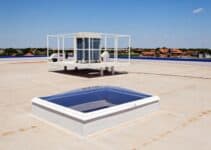With solar panels, you get a free and clean source of energy. Hence, there is no telling how much you can harness this electricity to power your different appliances in the home. But, several times, handy homeowners wonder and ask if they can power or operate their welder on a solar panel.
A welder is not the highest-consuming energy equipment out there. Thus, it will be able to run on a solar panel. However, the equipment can only run if the inverter can handle the power. Otherwise, it can lead to a severe case of overheating.
Suppose you would love to gain more insight into the use of your welder with your solar panel. This post will teach you everything you need to know about solar panels and welders. Let’s dive in!
Can Solar Panel Run Welding Machine?
Nowadays, several welding machines fill the market for the benefit of DIYers, hobbyists, or those who might require a welder in their immediate surroundings. A common question asked by several is if solar panels can be used to run these welding machines?
Yes, solar panels can be used to run a welding machine. However, before you run a welder on your solar panel system, you must understand the energy consumption of the welder. This will help you figure out if the solar panels are strong enough to power the welding machine.
A welder uses a massive current in a short period. So, a typical welding machine uses around 7 to 12 kWh. Therefore, the timeframe for a typical session should not take more than 20 minutes. Still, to understand the power consumption of your welder, you need to calculate it to be sure your solar panel can handle it.
The formula you need is:
Power (W /kW) = Voltage x Current /Efficiency
For example, suppose a 24V, 150 amp welding machine with 0.89 efficiencies is required to run for 30 minutes. How many solar panels can power the welder?
You calculate with the formular and have, Power (W / kW) = 24V X 150 amp / 0.89
Power = 4045 Watts.
Hence, you can easily deduce from the power that 4045W is required to run the welder for an hour. For 30 minutes, the welder will require about 2022 watts. Therefore, the welding machine can run for 30 minutes with a 3000W solar generator or 7 X 300W solar panels.
What is Solar Welding?
Solar welding is simply running a welding machine on a solar power source such as a solar generator or solar panel. As clean and eco-friendly electricity becomes more integrated into our lives, it is only appropriate to utilize them for activities such as welding.
You can run a welder on any source of electricity. Still, solar is a cost-effective and environmentally friendly source to run the equipment.
How To Get The Most Out of Solar Welding?
To get the most out of your solar generator or panels, the first thing you need to pay more attention to is surge power and running power.
As the name implies, surge power is when the electrical current powering your appliances exceeds the suitable average. For instance, the standard wall outlet in the US supplies 120 volts. Therefore, if the electricity supply exceeds 150 volts, there will likely be a surge despite a few fluctuations.
Surge power is usually higher than the running power, so ensure that you do not make mistakes when purchasing any appliances. Usually, a welding machine does not have surge requirements, but the power source running watts must not be less than that of the welding machine.
Understanding the surge power and running power will help you run the welding machine on a suitable solar power. Yet, another thing to watch out for is the battery. It is possible but impractical to run solar welding directly from solar panels.
Because of the unpredictable sun, which can get bright or dark without warning, it would help if you had large batteries to avoid unplanned cutting short of work during weather shifts. It is also more resistant to over-draining and keeps your welding machine running for a longer timeframe.
You could also get a pure sine inverter which helps produce clean and noiseless electricity. It also allows extending power backup.
How To Run a Welder On Solar?
A solar system must contain essential parts such as the panels, charge controller, an inverter, and batteries to run any appliance. Each of these four components plays a significant role in running a welder on solar. So now, let’s get down to how to run a welding machine or solar power.
Step 1:
Connecting solar panels can seem challenging, but it’s not that difficult. All you need to do is connect the positive terminal to the negative terminal of every panel. Then, the electrical connection of the solar panel in series is used to increase the system output voltage. How?
The solar panels sum up the voltage produced by each panel, giving a total output of all the solar panels. For instance, if a panel gives 12V, three panels give 36V.
Step 2:
The inverter is a vital part of your solar panel. First, it transforms the sunlight absorbed by your panels into adequate power that your appliances can use. Then, it stores it in the batteries. Thus, there is a crucial relationship between your solar panels, inverter, and batteries.
Use battery cables and DC wires with gauges to connect your inverter between the solar panels and battery. Don’t forget to make use of the pure sine inverter’s manual.
Step 3:
The third step is relatively easy; it’s what you have been anticipating. All that’s required is to connect your welding machine to the power source and use it.
As a tip, we advise that you use a DC safety disconnect during your inverter and battery connection to secure your circuit from excessive voltage.
Benefits of Solar Welding
There are several benefits attached to using solar power for welding. Let’s take a look at some of them below:
1. Eco friendly
You probably know this, but anything powered by the sun through solar panels is eco-friendly. Sunlight is a renewable source that produces one of the cleanest energy sources in the world. The American Chemical Society asserts this by stating that solar technologies induce less air emission per GWh than fossil fuel-based electricity after a thorough comparison.
2. Convenience
One of the best things about solar electricity is that you don’t have to be indoors or connect your welding machine to direct power to get work done. You can use a welder anytime, including off the utility grid. The off-grid solar system enables you to harness the electricity stored in the battery bank.
3. Low Maintenance
Solar panels are durable and require low maintenance. In other words, they do not need much besides regular cleaning. Hence, if you run a welding business, you won’t have to worry about repairs for your power source.
Suppose you regularly work outdoors. In that case, solar panels can cut back your expenditures such as fossil fuels for fueling a generator or regular repairs and maintenance.
4. Cost-Effective
We will come to the topic of the initial investment of solar panels in a minute and discuss how hefty it is. First, however, one must not overlook how a solar system can save you some bucks on electricity if you do a lot of welding work.
You might not save thousands of dollars, but it’s worth going solar for your welding work because you will notice a significant reduction in your monthly electricity bills.
Limitations of Solar Welding
1. High Cost of Installation
The initial cost of solar panels is reasonably high. But, if you have ever invested in one, you know how not so pocket-friendly they are. Still, the increased investment is worth the benefits over time.
2. Weather Dependent
Solar welding makes your welding a subject of the sun. This is because solar panels get their energy from electricity before converting it to suitable power for your appliance. It is vital to note that solar panels can generate electricity from the UV rays passing through the clouds. However, it might not generate enough electricity to power your welding machine if it’s not mainly a sunny day.
Frequently Asked Questions
What Is An Inverter-based Welding Machine?
An inverter-based welding machine does not depend primarily on a single source to regulate voltage. Instead, it works by controlling its frequency and rectifying currents by itself.
This is due to the recent silicon technology integrated with inverter-based welding machines to help them manage the welding process electronically. It also has features such as overload protection to help control the output power of the welding machine.
Are Inverter-based Welding Machines Better For Small-scale Welding?
Yes, they are. Several advantages are attached to using an inverter-based welding machine. Still, one of the best ones is that they are convenient and easy to use. Thus, making them suitable for small-scale welding.
They also give flexible control because of the inverters component’s ability to regulate its power supply. Unlike conventional welders, these welding machines use less power and do not take much space. This makes it easy to move around and use for small-scale jobs.
What Is The Solar-powered Helmet?
Welding helmets are the most crucial protection for a welder; they protect the eyes and face from harmful radiation emitted from the welding process. Solar-powered helmets are one of the types of welding helmets available.
Like all solar-powered equipment, they use solar panels to capture the sunlight, transform it into power, and store it in the battery. Hence, they store power while in the sun, and with a larger battery bank, they can store enough battery to last you for a more extended period.
Do Solar Welding Helmets Need Charging?
No, solar welding helmets do not need charging from traditional power sources. Instead, they use solar power, which they can utilize due to their photovoltaic cells on top of the equipment. Hence, the sunlight charges the PV cells on the solar-powered helmets, converts them, and stores them in the batteries.
It is also important to note that this solar-powered helmet does not only work in the sun. Although they require sunlight to be charged and power them up, you can use them indoors after charge.
Conclusion
Welding machines are heavy pieces of equipment. Thus, they are expected to consume a lot of energy. Basic knowledge, a lot of power equals more electricity bills. So, solar welding is one of the cost-effective ways to do your welding activities.
Solar welding doesn’t only reduce your electricity costs; it offers you the convenience that you require during the welding process. Plus, you could collect the energy and save it for other purposes when not welding.






